Design, Technical and Economic Optimization of Renewable Energy-Based Electric Vehicle Charging Stations in Africa: The Case of Nigeria
Abstract
:1. Introduction
2. Literature Review
| System Configuration | Operating Mode | Country | Sensitivity Variables | Year | Evaluation Parameters | Refs |
|---|---|---|---|---|---|---|
| PV/Wind/Fuel cell/battery | Off grid | India | Nil | 2022 | NPC/OPEX/COE | [36] |
| PV/Grid/battery | On/Off-grid | Vietnam | Solar EVCS | 2021 | NPC/COE/RF | [37] |
| CPV/WT/Bio-Gen/FC/Battery | Stand-alone | Qatar | WT hub heights. | 2021 | NPC/COE/Unmet load | [33] |
| PV/Grid/Battery | Grid-based | India | Nil | 2021 | RF/COE/Prod./GHG | [28] |
| Wind/PV/battery | Stand-alone | Turkey | Nil | 2020 | NPC/Prod./COE | [38] |
| PV/Wind/Fuel cell/battery | Off grid | Romania | Nil | 2020 | COE/NPC/GHG | [29] |
| PV/WT/Grid/V2G | Grid-tied/V2G | Brazil | Nil | 2020 | LCOE/Prod./NPV | [30] |
| V2G technology | Grid-based | Indonesia | Nil | 2020 | GHG/Energy-supply/cost | [1] |
| PV/Biogas Gen/Grid/Battery | On/Off-grid | Bangladesh | Nil | 2018 | NPC/COE/GHG | [34] |
| DG/PV/Grid/Battery | On/Off-grid | Canada | Nil | 2017 | NPC/COE/GHG | [39] |
| PV/Grid/Battery | Grid-tied | Bulgaria | Nil | 2016 | COE/NPC/GHG | [40] |
| PV-Grid based | Grid-tied | China | Economic variables | 2015 | COE/GHG/NPC | [32] |
3. Methodology
3.1. Microgrids Design and Optimization Tool (HOMER)
| System Configuration | Application | Country | Simulation Tool/ | Year | Parameters | Refs. |
|---|---|---|---|---|---|---|
| PV/WT/DG/BES | Rural load | Nigeria | HOMER | 2021 | NPC/COE/GHG | [45] |
| WT/DG/FC/BES | Standalone | Saudi Arabia | HOMER | 2021 | NPC/COE | [46] |
| WT/BES/PV/DG | Off-grid | Malawi | HOMER | 2021 | COE/RF/NPV | [47] |
| PV/BES/GRID | On/Off Grid | Iraq | HOMER | 2020 | NPC/GHG/RF | [48] |
| PV/BES | Off-grid | Morocco | PVsyst/HOMER | 2019 | LCC/RF/COE | [49] |
| WT/DG/BES | Off-grid | Pakistan | HOMER/MATLAB | 2019 | THD/GHG/COE | [50] |
| WT/PV/BES/DG | Off-grid | Bangladesh | HOMER | 2018 | NPC/COE/GHG/ | [51] |
| GRID/PV | On-grid | Saudi Arabia | HOMER | 2018 | RF/NPC/COE | [52] |
| PV/WT/BES/FC | Off-grid | UAE | HOMER | 2017 | NPC/COE/GHG | [53] |
| WT/PV/DG/BES | Off-grid | Canada | HOMER | 2016 | GHGepc/COE | [54] |
| WT/PV/BES/DG | Off/On-grid | Sri Lanka | HOMER | 2015 | TNPC/LCOE | [55] |
| PV/DG/BES | Off-grid | India | HOMER | 2014 | NPC/RF | [56] |
| PV/DG/BES | Off-grid | Saudi Arabia | HOMER | 2010 | COE/RF | [57] |
3.2. Sites Details and Operating Strategy
3.3. Renewable Sources at the EVCS Case Study Locations
3.3.1. Wind Power Sources
3.3.2. Solar Power Resources
3.4. Mathematical Representation and Specifications of the Hybrid System Components
3.4.1. Wind Turbine System
3.4.2. Solar Photovoltaic System
3.4.3. Battery System
3.4.4. Converter
3.5. Evaluation Criteria
3.5.1. The Net Present Cost (NPC)
3.5.2. The Cost of Energy (COE)
3.5.3. The Renewable Fraction (RF)
3.5.4. The Unsatisfied Load
4. Results Analysis and Discussion
4.1. Load Data Estimation
4.2. Performance Assessment of the Proposed Charging Station Schemes
4.3. Sensitivity Evaluation
4.3.1. Economic Impact of Sensitivity Variables
4.3.2. Technical Impact of Sensitivity Variables
5. Conclusions
Author Contributions
Funding
Data Availability Statement
Conflicts of Interest
References
- Huda, M.; Koji, T.; Aziz, M. Techno Economic Analysis of Vehicle to Grid (V2G) Integration as Distributed Energy Resources in Indonesia Power System. Energies 2020, 5, 1162. [Google Scholar] [CrossRef] [Green Version]
- Ganapaneni, S.; Pinni, S.V.; Reddy, C.R.; Aymen, F.; Alqarni, M.; Alamri, B.; Kraiem, H. Distribution System Service Restoration Using Electric Vehicles. Energies 2022, 15, 3264. [Google Scholar] [CrossRef]
- International Energy Agency. Nigeria Energy Outlook. Available online: https://www.iea.org/articles/nigeria-energy-outlook (accessed on 28 October 2021).
- Bank, T.W. The World Bank in Nigeria. Available online: https://data.worldbank.org/indicator/EG.ELC.ACCS.ZS?end=2019&locations=NG&start=1990&view=chart (accessed on 31 October 2021).
- EnerData. Nigeria Energy Information. Available online: https://www.enerdata.net/estore/energy-market/nigeria/ (accessed on 17 July 2022).
- Green Environment& Energy Conservation Initiative. Energy Consumption in Transport Sector in Nigeria. Available online: https://geeci.org/html/news/energy-transport-nigeria.html (accessed on 19 September 2022).
- Alade, B. FG to Incorporate Electric Vehicles in Revised NAIDP. Available online: https://guardian.ng/features/fg-to-incorporate-electric-vehicles-in-revised-naidp/ (accessed on 2 November 2021).
- Daka, T. Osinbajo Unveils First Made-in-Nigeria Electric Car. Available online: https://guardian.ng/news/osinbajo-unveils-first-made-in-nigeria-electric-car/ (accessed on 1 November 2021).
- Ajimotokan, O. Stallion Motor Unveils Nigeria’s First Electric Car in Abuja. Available online: https://www.thisdaylive.com/index.php/2021/02/06/stallion-motor-unveils-nigerias-first-electric-car-in-abuja/ (accessed on 1 November 2021).
- JET Motor Company. Heralding the African Electric Future. Available online: https://www.jetmotorcompany.com/jet-mover-ev/ (accessed on 3 November 2021).
- Onu, E. Chinese Parts Help JET Motor Assemble First EV Vans in Nigeria. Available online: https://www.bloomberg.com/news/articles/2021-07-29/chinese-parts-help-jet-motors-assemble-first-ev-vans-in-nigeria (accessed on 3 November 2021).
- Idajili, A. Meet the JET EV, Nigeria’s First Electric-Powered van by Jet Motor Company. 2021. Available online: https://www.techcityng.com/meet-jet-ev-nigerias-first-electric-powered-van-by-jet-motor-company/ (accessed on 3 November 2021).
- Echewofun, S.; Aliyu, A.; Ugwuezuoha, Y. FG Commissions Solar-Powered Charging Station for Electric Vehicles. Available online: https://dailytrust.com/fg-commissions-solar-powered-charging-station-for-electric-vehicles (accessed on 3 November 2021).
- Vanguard. NADDC Inaugurates 1st Nigeria Electric Vehicle Charging Station in Sokoto. Available online: https://www.vanguardngr.com/2021/04/naddc-inaugurates-1st-nigeria-electric-vehicle-charging-station-in-sokoto/ (accessed on 1 November 2021).
- Odunsi, W. Nigerian Govt Commissions Electric Vehicle Charging Station in Lagos. Available online: https://dailypost.ng/2021/07/13/nigerian-govt-commissions-electric-vehicle-charging-station-in-lagos/ (accessed on 1 November 2021).
- Olisah, C. Sanwo-Olu Launches Nigeria’s First Electric Car, to Complete Lagos-Badagry Expressway. Available online: https://nairametrics.com/2020/11/13/sanwo-olu-launches-nigerias-first-electric-car-to-complete-lagos-badagry-expressway/ (accessed on 1 November 2021).
- Alade, B. GIG Logistics, Jet Motor Partner on Electric Vehicles. Available online: https://guardian.ng/features/gig-logistics-jet-motor-partner-on-electric-vehicles/ (accessed on 3 November 2021).
- Singh, S.; Chauhan, P.; Singh, N.J. Feasibility of Grid-Connected Solar-Wind Hybrid System with Electric Vehicle. J. Mod. Power Syst. Clean Energy 2021, 9, 295–306. [Google Scholar] [CrossRef]
- Aliyu, A.K.; Modu, B.; Tan, C.W. A Review of Renewable Energy Development in Africa: A Focus in South Africa, Egypt and Nigeria. Renew. Sustain. Energy Rev. 2018, 81, 2502–2518. [Google Scholar] [CrossRef]
- Ajayi, O.O. Assessment of Utilization of Wind Energy Resources in Nigeria. Energy Policy 2009, 37, 750–753. [Google Scholar] [CrossRef]
- Nehrir, M.H.; Wang, C.; Strunz, K.; Aki, H.; Ramakumar, R.; Bing, J.; Miao, Z.; Salameh, Z. A Review of Hybrid Renewable/Alternative Energy Systems for Electric Power Generation: Configurations, Control, and Applications. IEEE Trans. Sustain. Energy 2011, 2, 392–403. [Google Scholar] [CrossRef]
- Ma, T.; Yang, H.; Lu, L. A Feasibility Study of a Stand-Alone Hybrid Solar–Wind–Battery System for a Remote Island. Appl. Energy 2014, 121, 149–158. [Google Scholar] [CrossRef]
- Okere, R. Government Plans 45,101 MW Electricity Generation by 2030. Available online: https://guardian.ng/business-services/government-plans-45101mw-electricity-generation-by-2030/ (accessed on 30 October 2021).
- Nigeria-Punch Newspaper. Renewable Energy Mix. Available online: https://punchng.com/fg-targets-30-per-cent-in-renewable-energy-mix-by-2030-fashola/ (accessed on 30 October 2019).
- Akikur, R.K.; Saidur, R.; Ping, H.W.; Ullah, K.R. Comparative Study of Stand-Alone and Hybrid Solar Energy Systems Suitable for off-Grid Rural Electrification: A Review. Renew. Sustain. Energy Rev. 2013, 27, 738–752. [Google Scholar] [CrossRef]
- Oyedepo, S.O. Energy and Sustainable Development in Nigeria: The Way Forward. Energy Sustain. Soc. 2012, 2, 15. [Google Scholar] [CrossRef] [Green Version]
- Karmaker, A.K.; Hossain, A.; Kumar, N.M. Analysis of Using Biogas Resources for Electric Vehicle Charging in Bangladesh: A Techno-Economic-Environmental Perspective. Sustainability 2020, 12, 2579. [Google Scholar] [CrossRef]
- Nigam, K. Feasibility Analysis of a Solar-Assisted Electric Vehicle Charging Station Model Considering Differential Pricing. Energy Storage 2021, 3, e237. [Google Scholar] [CrossRef]
- Filote, C.; Felseghi, R. Environmental Impact Assessment of Green Energy Systems for Power Supply of Electric Vehicle Charging Station. Int. J. Energy Res. 2020, 44, 10471–10494. [Google Scholar] [CrossRef]
- Machado, A.; Daniel, S.; Nogueira, H.; Soares, B.; César, M.; Diogo, G. Techno-Economic Feasibility Study on Electric Vehicle and Renewable Energy Integration: A Case Study. Energy Storage 2020, 2, e197. [Google Scholar] [CrossRef]
- Venkatesh, B.; Daniel, S.A. Design and Feasibility Analysis of Hybrid Energy-Based Electric Vehicle Charging Station. Distrib. Gener. Altern. Energy J. 2022, 37, 41–72. [Google Scholar] [CrossRef]
- Ye, B.; Jiang, J.; Miao, L.; Yang, P.; Li, J.; Shen, B. Feasibility Study of a Solar-Powered Electric Vehicle Charging Station Model. Energies 2015, 8, 13265–13283. [Google Scholar] [CrossRef] [Green Version]
- Al Wahedi, A.; Bicer, Y. Techno-Economic Optimization of Novel Stand-Alone Renewables-Based Electric Vehicle Charging Stations in Qatar. Energy 2022, 243, 123008. [Google Scholar] [CrossRef]
- Kumar, A.; Ahmed, R.; Hossain, A.; Sikder, M. Feasibility Assessment & Design of Hybrid Renewable Energy Based Electric Vehicle Charging Station in Bangladesh. Sustain. Cities Soc. 2018, 39, 189–202. [Google Scholar] [CrossRef]
- Manwell, J.M.; McGowan, J.G. Lead Acid Battery Storage Model for Hybrid Energy Systems. Sol. Energy 2003, 50, 399–405. [Google Scholar] [CrossRef]
- Syed Mohammed, A.; Anuj; Lodhi, A.S.; Murtaza, Q. Techno-Economic Feasibility of Hydrogen Based Electric Vehicle Charging Station: A Case Study. Int. J. Energy Res. 2022, 46, 14145–14160. [Google Scholar] [CrossRef]
- Minh, P.V.; Le Quang, S.; Pham, M. Technical Economic Analysis of Photovoltaic-Powered Electric Vehicle Charging Stations under Different Solar Irradiation Conditions in Vietnam. Sustainability 2021, 13, 3528. [Google Scholar] [CrossRef]
- Ekren, O.; Canbaz, C.H.; Güvel, Ç.B. Sizing of a Solar-Wind Hybrid Electric Vehicle Charging Station by Using HOMER Software. J. Clean. Prod. 2021, 279, 123615. [Google Scholar] [CrossRef]
- Hafez, O.; Bhattacharya, K. Optimal Design of Electric Vehicle Charging Stations Considering Various Energy Resources. Renew. Energy 2017, 107, 576–589. [Google Scholar] [CrossRef]
- Ilieva, L.M.; Iliev, S.P. Feasibility Assessment of a Solar-Powered Charging Station for Electric Vehicles in the North Central Region of Bulgaria. Renew. Energy Environ. Sustain. 2016, 1, 12. [Google Scholar] [CrossRef]
- HOMER Pro Software. Available online: www.homerenergy.com (accessed on 3 September 2022).
- Oladigbolu, J.O. Economic Evaluation and Determination of Optimal Hybrid Energy Supply Systems for Residential and Healthcare Facilities in Rural and Urban Areas. Ph.D. Thesis, King Abdulaziz University, Jeddah, Saudi Arabia, 2020. [Google Scholar]
- Sinha, S.; Chandel, S.S. Review of Software Tools for Hybrid Renewable Energy Systems. Renew. Sustain. Energy Rev. 2014, 32, 192–205. [Google Scholar] [CrossRef]
- Li, C.; Shan, Y.; Zhang, L.; Zhang, L.; Fu, R. Techno-Economic Evaluation of Electric Vehicle Charging Stations Based on Hybrid Renewable Energy in China. Energy Strateg. Rev. 2022, 41, 100850. [Google Scholar] [CrossRef]
- Oladigbolu, J.O.; Al-turki, Y.A.; Olatomiwa, L. Comparative Study and Sensitivity Analysis of a Standalone Hybrid Energy System for Electrification of Rural Healthcare Facility in Nigeria. Alex. Eng. J. 2021, 60, 5547–5565. [Google Scholar] [CrossRef]
- Seedahmed, M.M.A.; Ramli, M.A.M.; Bouchekara, H.R.E.H.; Shahriar, M.S.; Milyani, A.H.; Rawa, M. A Techno-Economic Analysis of a Hybrid Energy System for the Electrification of a Remote Cluster in Western Saudi Arabia. Alex. Eng. J. 2021, 61, 5183–5202. [Google Scholar] [CrossRef]
- Malanda, C.; Makokha, A.B.; Nzila, C.; Zalengera, C. Techno-Economic Optimization of Hybrid Renewable Electrification Systems for Malawi’s Rural Villages. Cogent Eng. 2021, 8, 1910112. [Google Scholar] [CrossRef]
- Aziz, A.S.; Tajuddin, M.F.N.; Adzman, M.R.; Mohammed, M.F.; Ramli, M.A.M. Feasibility Analysis of Grid-Connected and Islanded Operation of a Solar PV Microgrid System: A Case Study of Iraq. Energy 2020, 191, 116591. [Google Scholar] [CrossRef]
- El-houari, H.; Allouhi, A.; Rehman, S.; Buker, M.S. Design, Simulation, and Economic Optimization of an Off-Grid Photovoltaic System for Rural Electrification. Energies 2019, 12, 4735. [Google Scholar] [CrossRef]
- Ur, H.; Habib, R.; Wang, S.; Elkadeem, M.R.; Elmorshedy, M.F. Design Optimization and Model Predictive Control of a Standalone Hybrid Renewable Energy System: A Case Study on a Small Residential Load in Pakistan. IEEE Access 2019, 7, 117369–117390. [Google Scholar]
- Mandal, S.; Das, B.K.; Hoque, N. Optimum Sizing of a Stand-Alone Hybrid Energy System for Rural Electrification in Bangladesh. J. Clean. Prod. 2018, 200, 12–27. [Google Scholar] [CrossRef]
- Al Garni, H.Z.; Awasthi, A.; Ramli, M.A.M. Optimal Design and Analysis of Grid-Connected Photovoltaic under Different Tracking Systems Using HOMER. Energy Convers. Manag. 2018, 155, 42–57. [Google Scholar] [CrossRef]
- Aziz, A.S. Techno-Economic Analysis Using Different Types of Hybrid Energy Generation for Desert Safari Camps in UAE. Turk. J. Electr. Eng. Comput. Sci. 2017, 25, 2122–2135. [Google Scholar] [CrossRef]
- Rahman, M.M.; Khan, M.M.U.H.; Ullah, M.A.; Zhang, X.; Kumar, A. A Hybrid Renewable Energy System for a North American Off-Grid Community. Energy 2016, 97, 151–160. [Google Scholar] [CrossRef]
- Kolhe, M.L.; Ranaweera, K.M.I.U.; Gunawardana, A.G.B.S. Techno-Economic Sizing of off-Grid Hybrid Renewable Energy System for Rural Electrification in Sri Lanka. Sustain. Energy Technol. Assess. 2015, 11, 53–64. [Google Scholar] [CrossRef]
- Suresh Kumar, U.; Manoharan, P.S. Economic Analysis of Hybrid Power Systems (PV/Diesel) in Different Climatic Zones of Tamil Nadu. Energy Convers. Manag. 2014, 80, 469–476. [Google Scholar] [CrossRef]
- Rehman, S.; Al-Hadhrami, L.M. Study of a Solar PV-Diesel-Battery Hybrid Power System for a Remotely Located Population near Rafha, Saudi Arabia. Energy 2010, 35, 4986–4995. [Google Scholar] [CrossRef]
- Banguero, E.; Correcher, A.; Pérez-Navarro, Á.; Morant, F.; Aristizabal, A. A Review on Battery Charging and Discharging Control Strategies: Application to Renewable Energy Systems. Energies 2018, 11, 1021. [Google Scholar] [CrossRef] [Green Version]
- Trading-Economics. Economic Rates. Available online: https://tradingeconomics.com (accessed on 27 September 2022).
- Dalton, G.J.; Lockington, D.A.; Baldock, T.E. Feasibility Analysis of Stand-Alone Renewable Energy Supply Options for a Large Hotel. Renew. Energy 2008, 33, 1475–1490. [Google Scholar] [CrossRef]
- Orrico, A.C.A.; Schwingel, A.W.; Gimenes, R.M.T.; Souza, S.V.; Orrico, M.A.P.; Maciel, T.T.; Borquis, R.R.A.; de Vargas, F.M. Can Adding Liquid Hatchery Waste to Sheep Manure Potentialize Methane Production and Add Value to Sheep Farming? Environ. Technol. Innov. 2021, 24, 101866. [Google Scholar] [CrossRef]
- Adaramola, M.S.; Paul, S.S.; Oyewola, O.M. Assessment of Decentralized Hybrid PV Solar-Diesel Power System for Applications in Northern Part of Nigeria. Energy Sustain. Dev. 2014, 19, 72–82. [Google Scholar] [CrossRef]
- NASA/SSE. Surface Meteorology and Solar Energy. Available online: https://power.larc.nasa.gov/ (accessed on 15 December 2021).
- Ohunakin, O.S.; Adaramola, M.S.; Oyewola, O.M.; Fagbenle, R.O. Solar Energy Applications and Development in Nigeria: Drivers and Barriers. Renew. Sustain. Energy Rev. 2014, 32, 294–301. [Google Scholar] [CrossRef]
- Oladigbolu, J.O.; Ramli, M.A.M.; Al-turki, Y.A. Techno-Economic and Sensitivity Analyses for an Optimal Hybrid Power System Which Is Adaptable and Effective for Rural Electrification: A Case Study of Nigeria. Sustainability 2019, 11, 4959. [Google Scholar] [CrossRef] [Green Version]
- Agarwal, N.; Kumar, A.; Varun. Optimization of Grid Independent Hybrid PV-Diesel-Battery System for Power Generation in Remote Villages of Uttar Pradesh, India. Energy Sustain. Dev. 2013, 17, 210–219. [Google Scholar] [CrossRef]
- Khan, F.A.; Pal, N.; Saeed, S.H. Optimization and Sizing of SPV/Wind Hybrid Renewable Energy System: A Techno-Economic and Social Perspective Hybrid Optimization of Multiple Energy Resources. Energy 2021, 233, 121114. [Google Scholar] [CrossRef]
- Oladigbolu, J.O.; Ramli, M.A.M.; Al-Turki, Y.A. Optimal Design of a Hybrid PV Solar/Micro-Hydro/Diesel/Battery Energy System for a Remote Rural Village under Tropical Climate Conditions. Electronics 2020, 9, 1491. [Google Scholar] [CrossRef]
- Imam, A.A.; Oladigbolu, J.O.; Mustafa, M.A.S.; Imam, T.A. The Effect of Solar Photovoltaic Technologies Cost Drop on the Economic Viability of Residential Grid-Tied Solar PV Systems in Saudi Arabia. In Proceedings of the 2022 International Conference on Electrical, Computer and Energy Technologies (ICECET), Prague, Czech Republic, 20–22 July 2022; pp. 1–5. [Google Scholar] [CrossRef]
- Lambert, T.; Gilman, P.; Lilienthal, P. Micropower System Modeling. Integr. Altern. Sources Energy 2006, 1, 379–418. [Google Scholar]

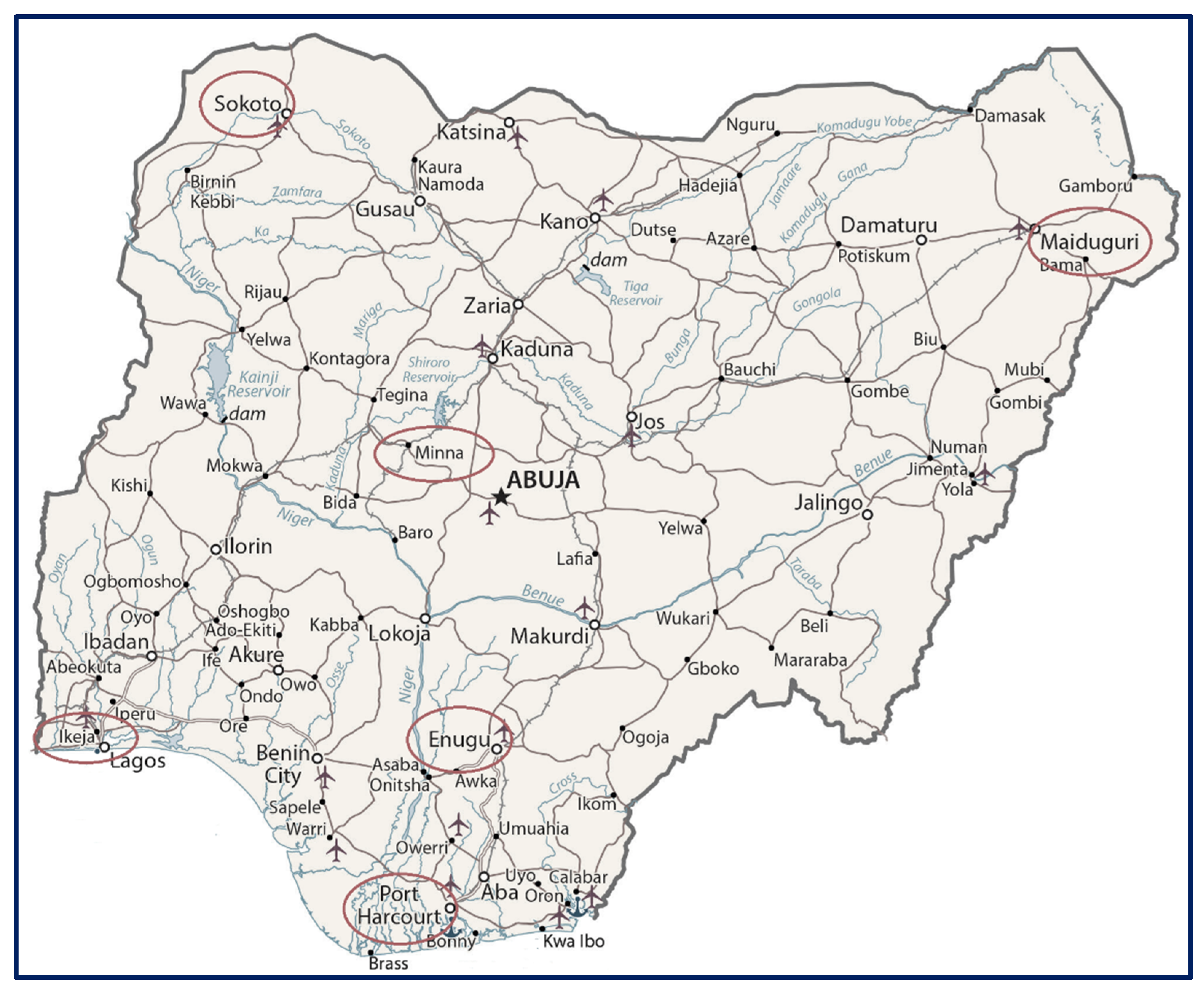
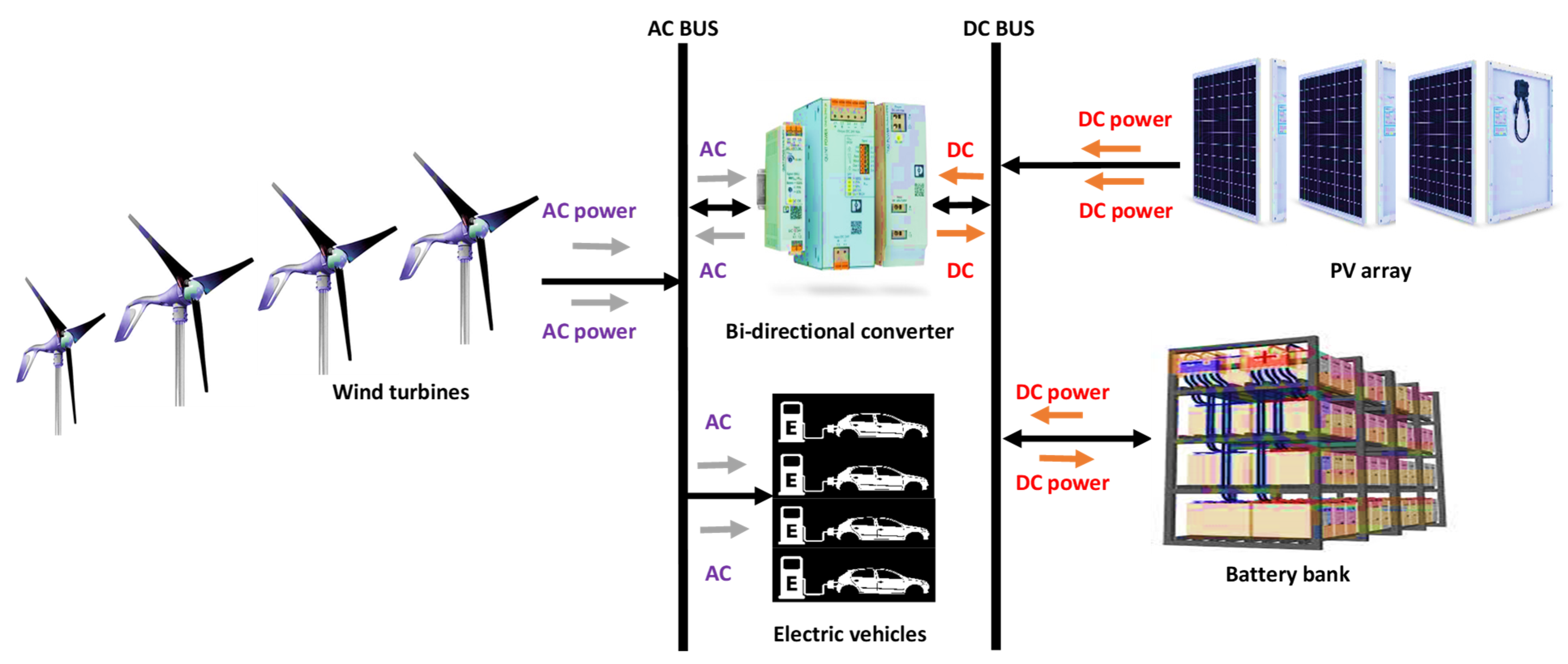
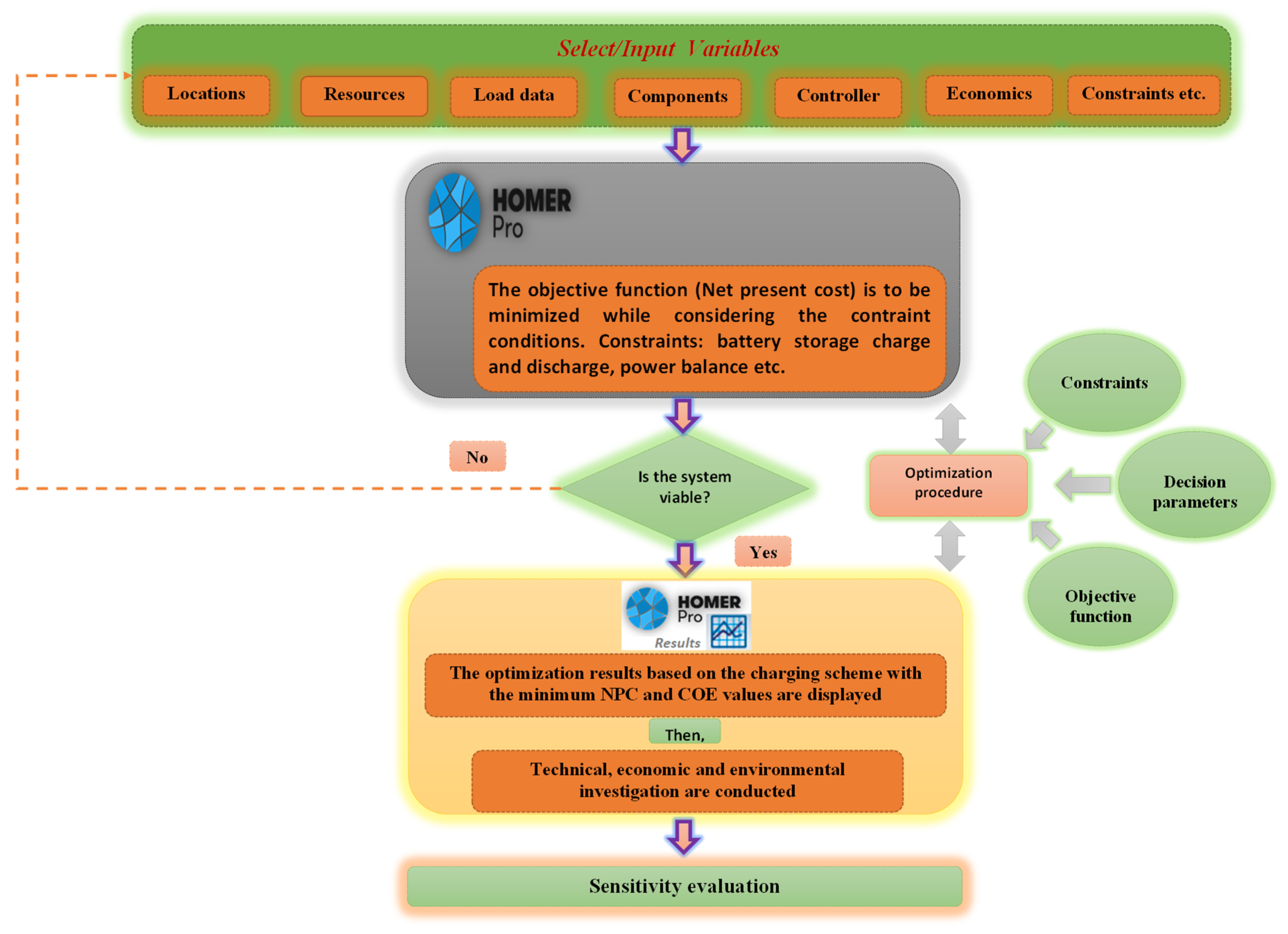
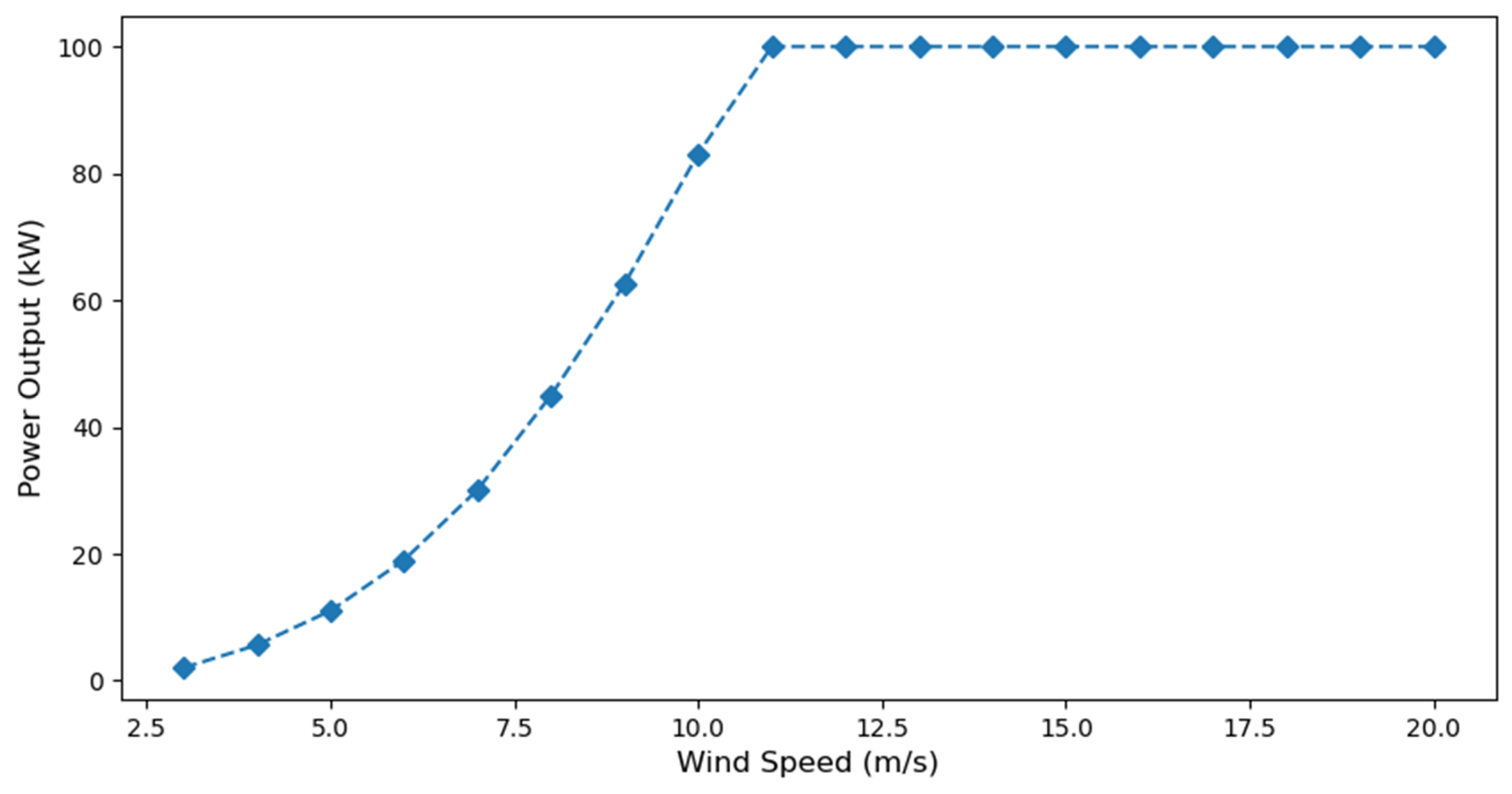

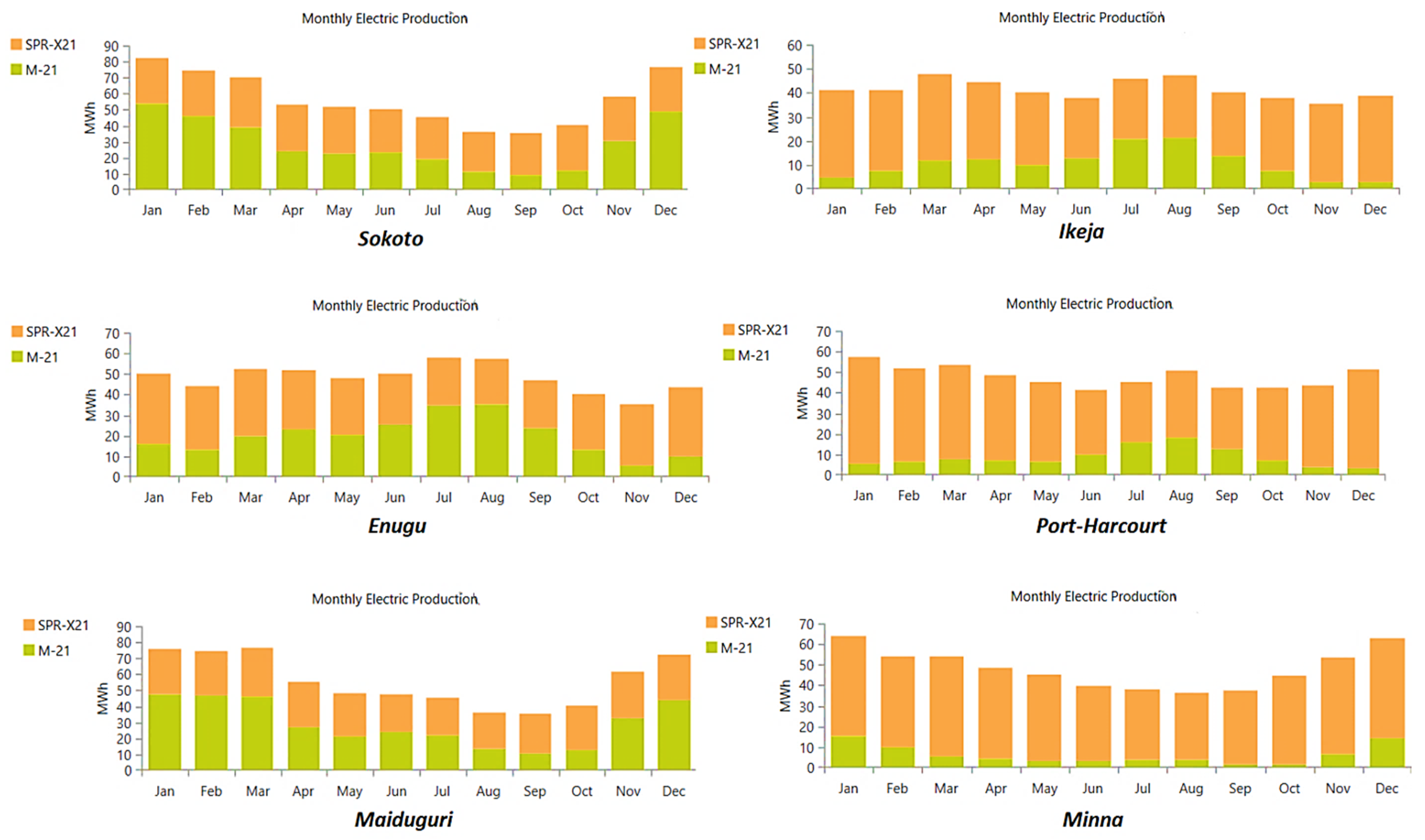
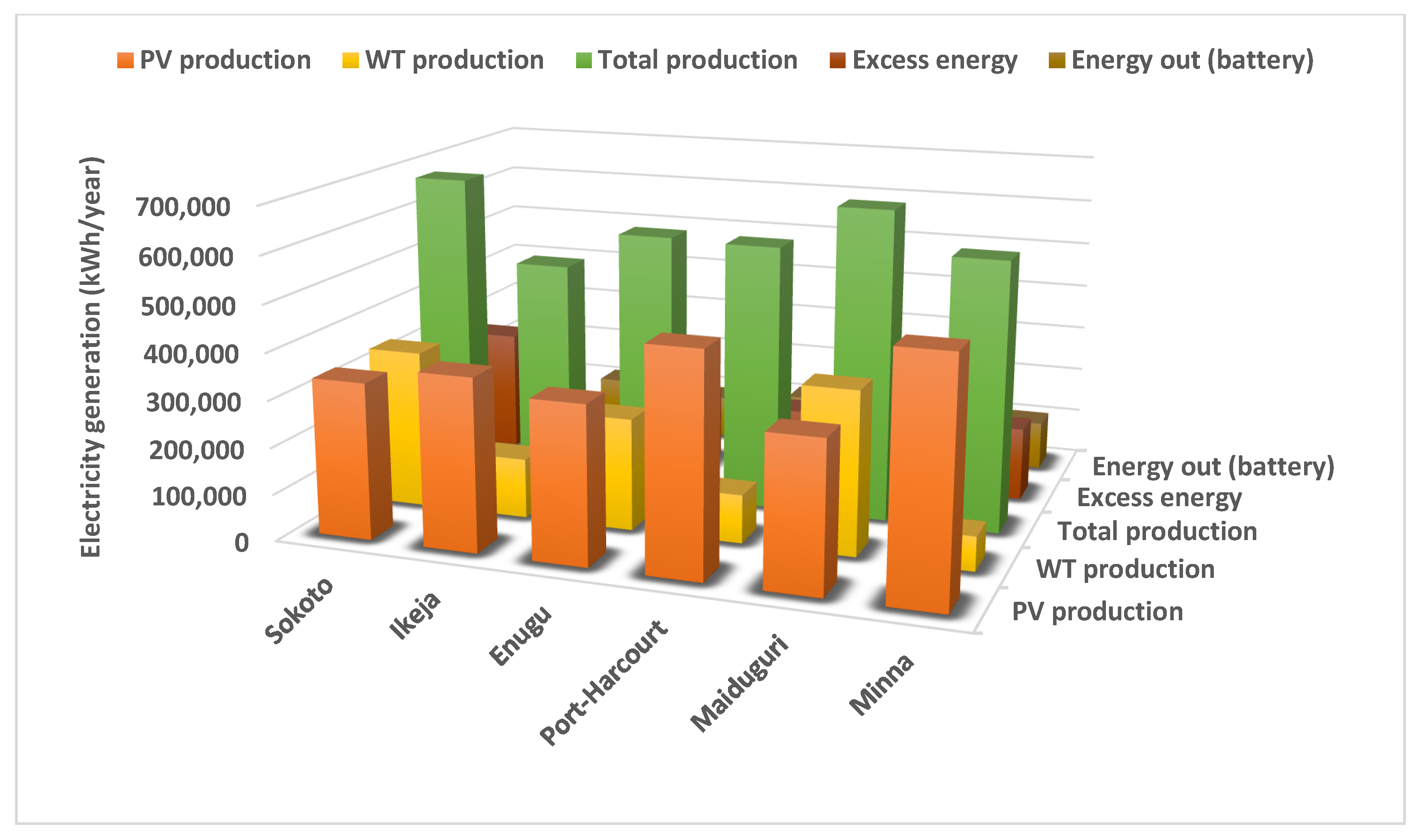
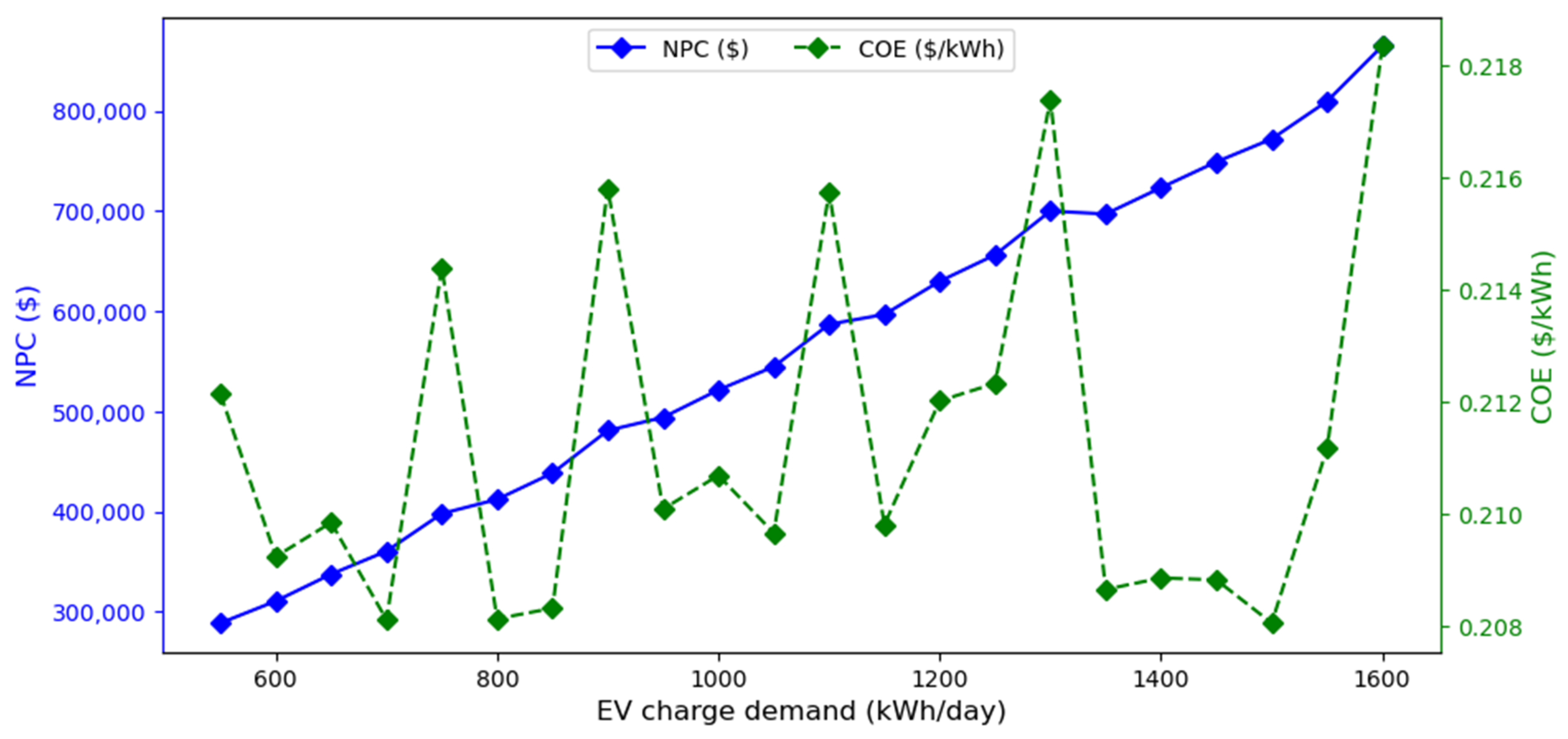
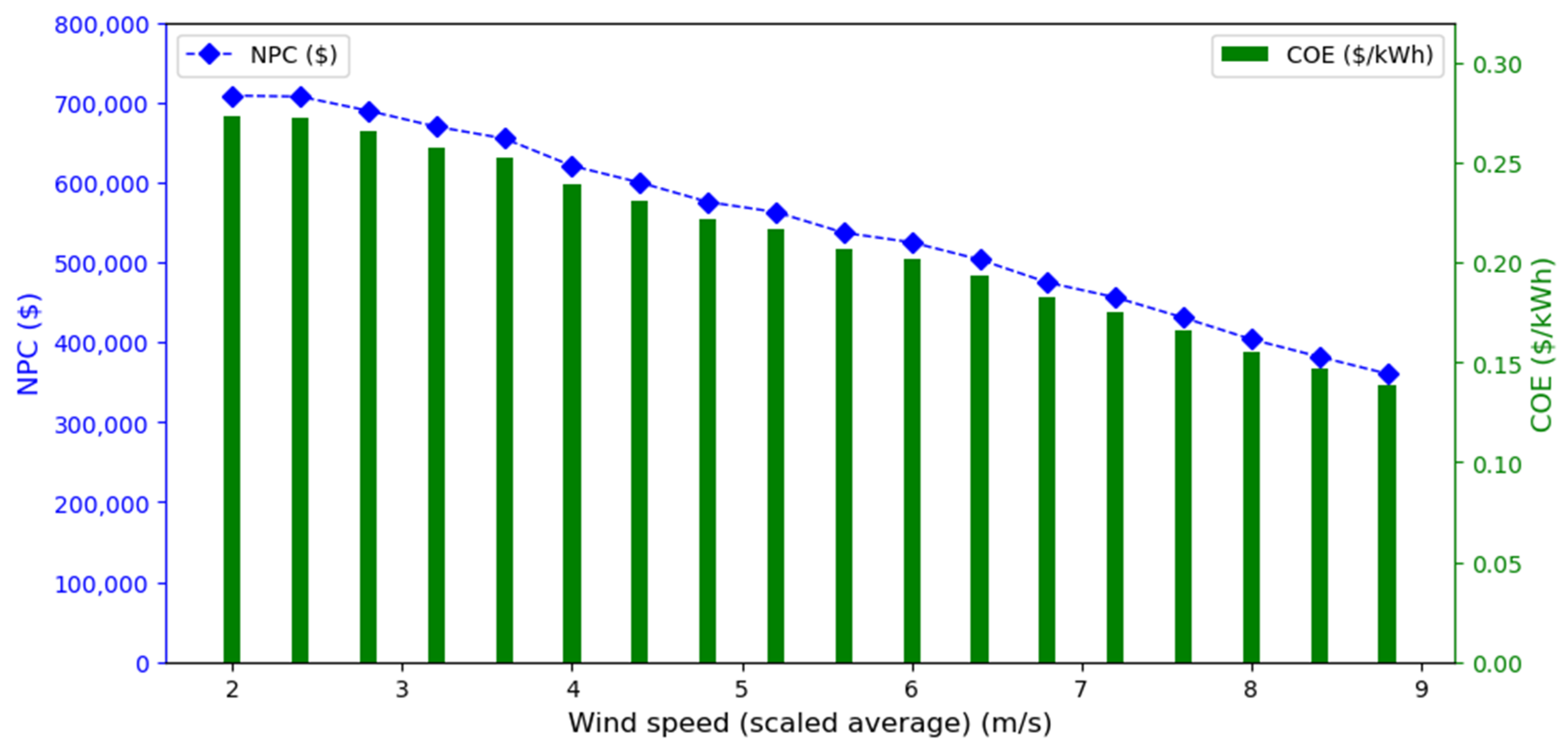
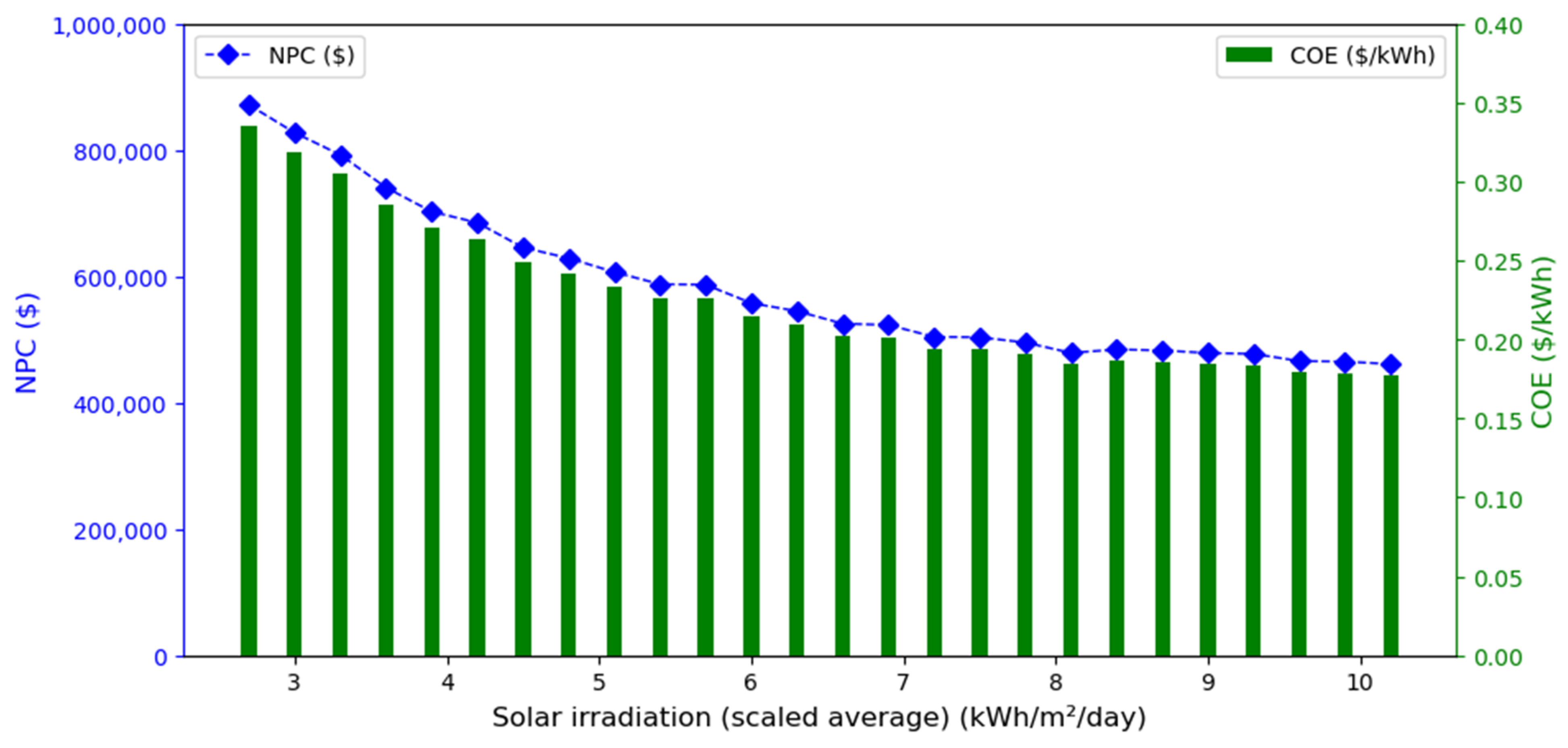
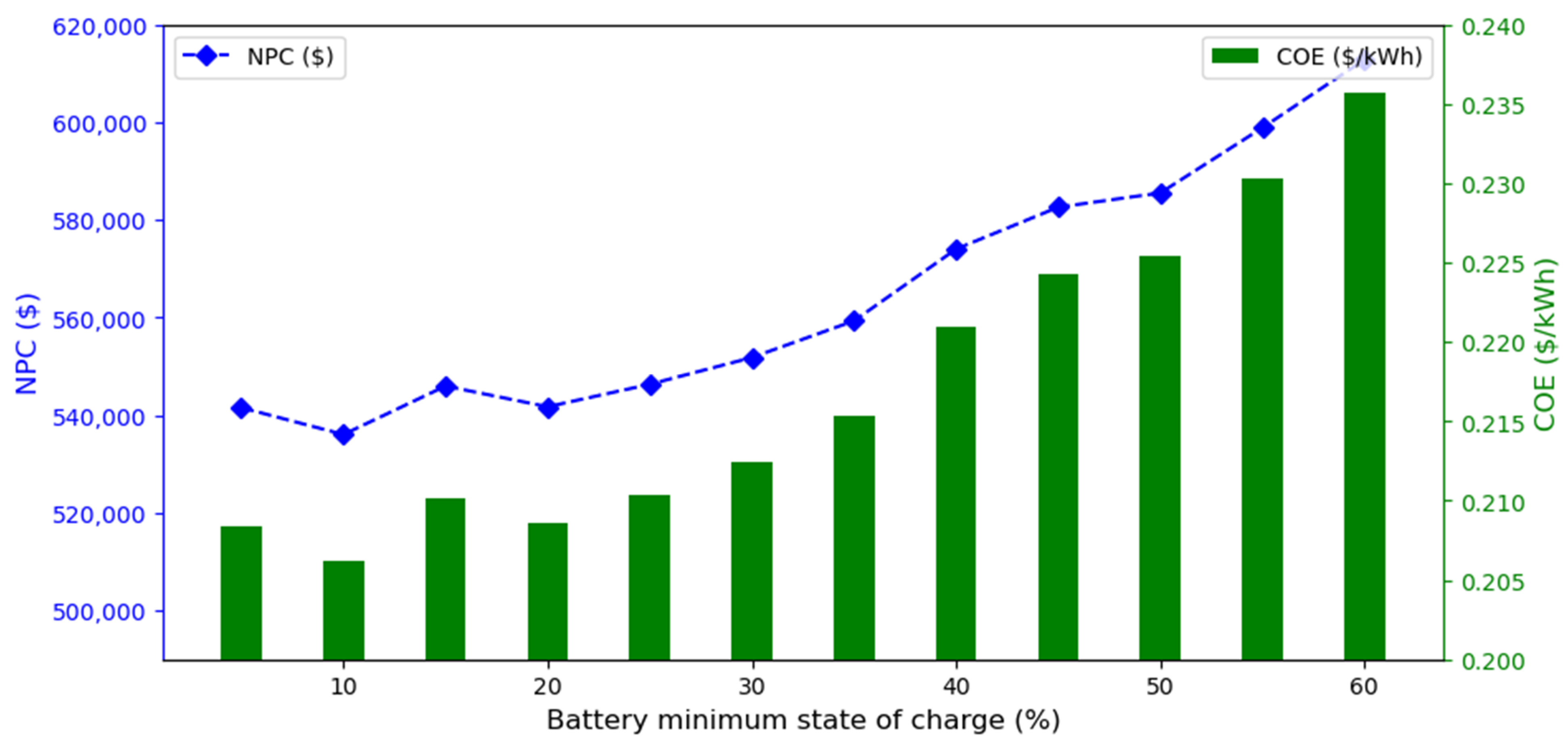
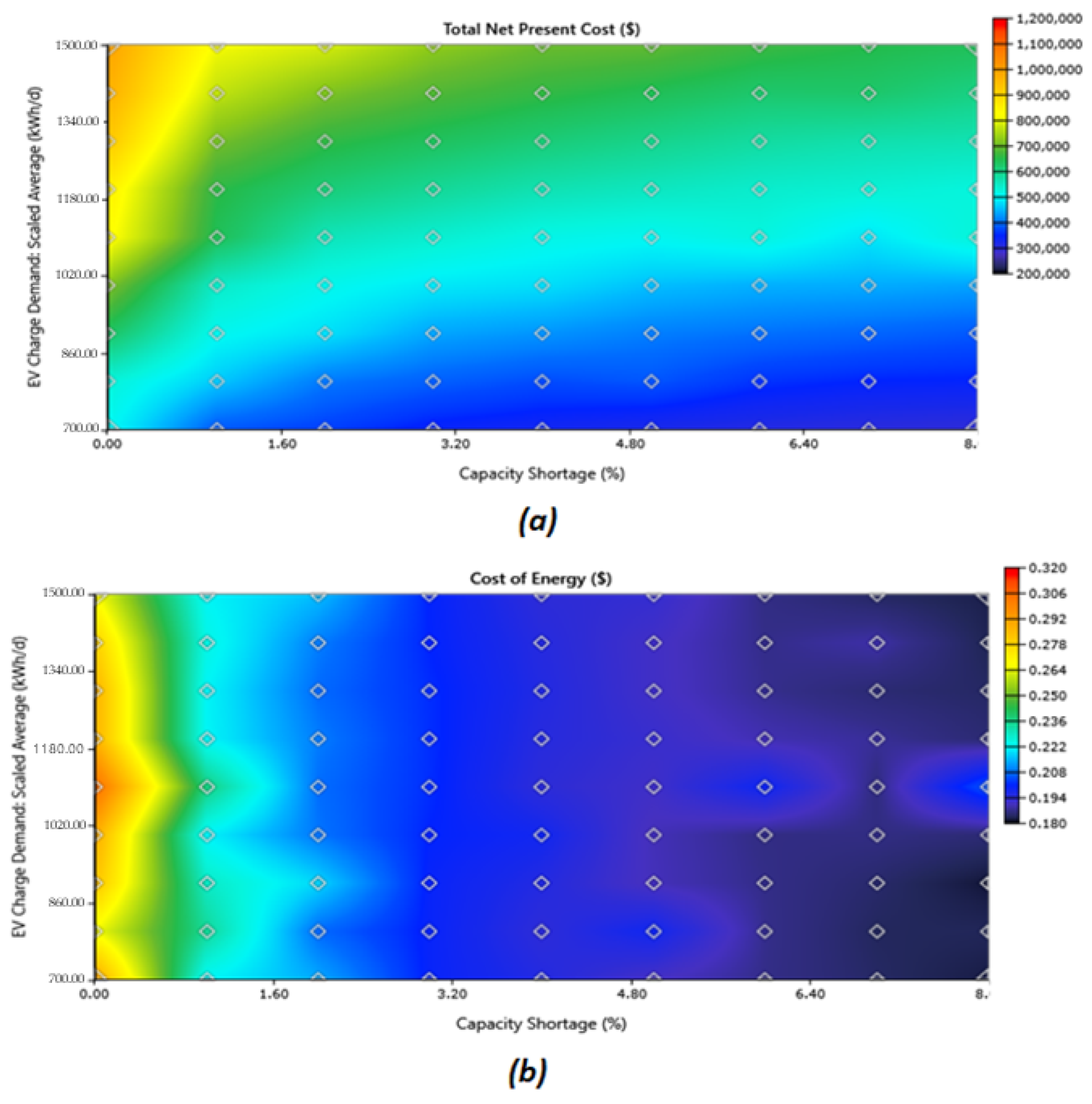



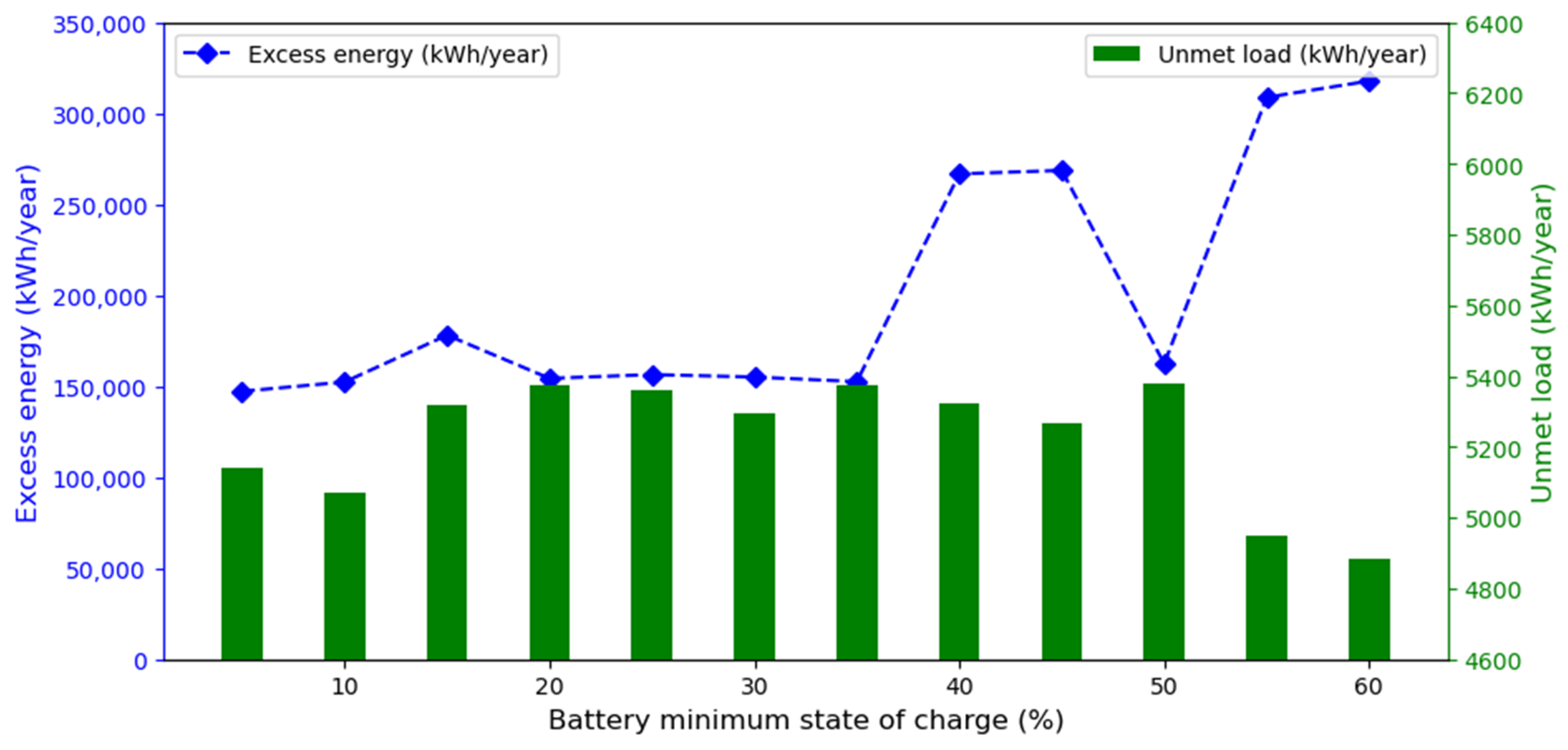
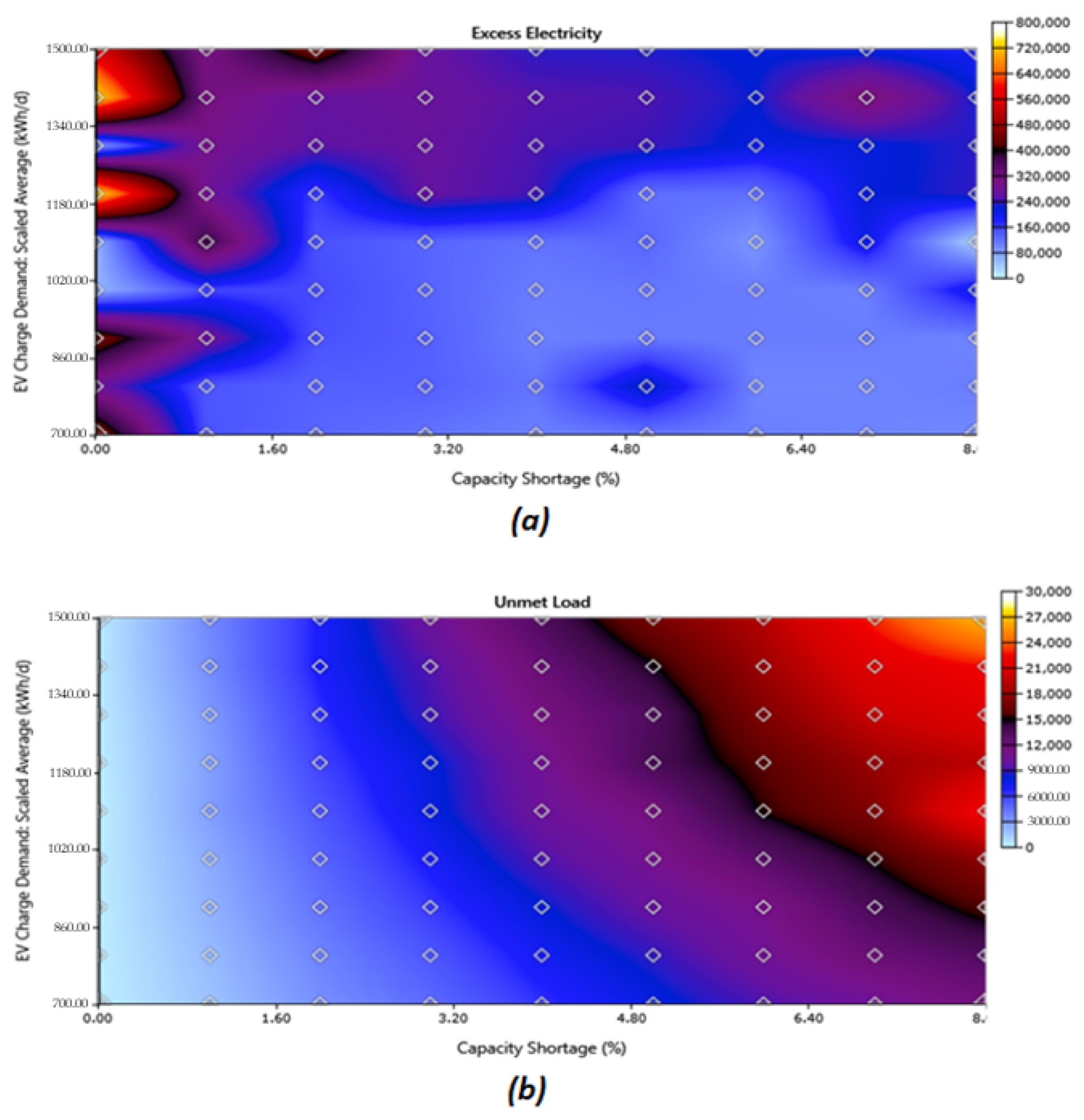
| State | City | Geo-Political Zone | Latitude (°N) | Longitude (°E) | Altitude (m) |
|---|---|---|---|---|---|
| Sokoto | Sokoto | North-West | 13.0059 | 5.2476 | 293.00 |
| Lagos | Ikeja | South-West | 6.6018 | 3.3515 | 46.00 |
| Enugu | Enugu | South-East | 6.4483 | 7.5139 | 200.00 |
| Rivers | Port-Harcourt | South-South | 4.8472 | 6.9746 | 13.00 |
| Borno | Maiduguri | North-East | 11.8311 | 13.1510 | 325.00 |
| Niger | Minna | North-Central | 9.5836 | 6.5463 | 446.00 |
| Variables | Unit | Value |
|---|---|---|
| Initial state of charge (SOCinitial) | % | 100 |
| Minimum SOC (SOCminimum) | % | 20 |
| Consider ambient temperature impact | Yes | Yes |
| Tracking system | No | No |
| Considered PV panel slope | Yes | Yes |
| Allowing system with multiple sources | Yes | Yes |
| System design precision | - | 0.010 |
| NPC precision | - | 0.010 |
| Economics | ||
| Real discount rate | % | 14 |
| Project lifetime | years | 25 |
| Constraints | ||
| Minimum renewable fraction (RFminimum) | % | 0 |
| Load in current time step | % | 10 |
| Solar power output | % | 25 |
| Wind power output | % | 50 |
| Month | Locations | |||||
|---|---|---|---|---|---|---|
| Sokoto | Ikeja | Enugu | Port-Harcourt | Maiduguri | Minna | |
| January | 7.25 | 3.07 | 3.83 | 2.81 | 6.78 | 5.69 |
| February | 7.07 | 3.61 | 3.76 | 3.01 | 7.12 | 5.01 |
| March | 6.25 | 4.04 | 4.14 | 3.12 | 6.77 | 4.00 |
| April | 5.23 | 4.10 | 4.40 | 3.05 | 5.49 | 3.75 |
| May | 5.10 | 3.78 | 4.18 | 2.95 | 4.96 | 3.45 |
| June | 5.19 | 4.16 | 4.55 | 3.36 | 5.20 | 3.37 |
| July | 4.79 | 4.84 | 5.00 | 3.83 | 4.97 | 3.54 |
| August | 3.97 | 4.90 | 5.03 | 4.00 | 4.21 | 3.51 |
| September | 3.78 | 4.28 | 4.41 | 3.60 | 3.96 | 2.86 |
| October | 4.09 | 3.50 | 3.65 | 3.05 | 4.11 | 2.75 |
| November | 5.68 | 2.74 | 2.83 | 2.56 | 5.86 | 4.23 |
| December | 6.90 | 2.65 | 3.33 | 2.43 | 6.56 | 5.48 |
| Average | 5.44 | 3.81 | 4.09 | 3.15 | 5.50 | 3.97 |
| Month | Locations | |||||
|---|---|---|---|---|---|---|
| Sokoto | Ikeja | Enugu | Port-Harcourt | Maiduguri | Minna | |
| January | 5.47 | 5.28 | 5.68 | 5.24 | 5.61 | 5.72 |
| February | 6.41 | 5.49 | 5.74 | 5.13 | 6.30 | 6.01 |
| March | 6.87 | 5.46 | 5.57 | 4.73 | 6.70 | 6.26 |
| April | 7.15 | 5.21 | 5.25 | 4.50 | 6.62 | 6.12 |
| May | 7.03 | 4.76 | 4.94 | 4.09 | 6.36 | 5.73 |
| June | 6.91 | 4.04 | 4.54 | 3.45 | 5.97 | 5.17 |
| July | 6.26 | 3.95 | 4.14 | 3.11 | 5.43 | 4.64 |
| August | 5.73 | 3.98 | 3.91 | 3.42 | 5.14 | 4.36 |
| September | 6.01 | 4.09 | 4.19 | 3.22 | 5.57 | 4.82 |
| October | 6.03 | 4.55 | 4.57 | 3.60 | 5.89 | 5.42 |
| November | 5.79 | 4.95 | 5.11 | 4.18 | 5.84 | 5.85 |
| December | 5.25 | 5.17 | 5.46 | 4.88 | 5.35 | 5.73 |
| Average | 6.24 | 4.74 | 4.93 | 4.13 | 5.90 | 5.49 |
| Month | Locations | |||||
|---|---|---|---|---|---|---|
| Sokoto | Ikeja | Enugu | Port-Harcourt | Maiduguri | Minna | |
| January | 23.03 | 25.90 | 24.02 | 25.40 | 23.35 | 22.90 |
| February | 25.91 | 26.94 | 25.68 | 26.43 | 26.16 | 25.19 |
| March | 29.71 | 27.22 | 26.60 | 26.73 | 29.98 | 27.20 |
| April | 32.84 | 26.99 | 26.62 | 26.53 | 32.77 | 27.49 |
| May | 33.00 | 26.53 | 26.16 | 26.19 | 32.77 | 26.52 |
| June | 31.06 | 25.59 | 25.29 | 25.31 | 30.94 | 25.41 |
| July | 28.48 | 24.65 | 24.60 | 24.61 | 28.17 | 24.48 |
| August | 26.80 | 24.41 | 24.58 | 24.52 | 26.61 | 24.23 |
| September | 27.09 | 24.92 | 24.78 | 24.83 | 27.23 | 24.82 |
| October | 27.86 | 25.55 | 25.05 | 25.26 | 28.22 | 25.19 |
| November | 25.91 | 26.27 | 25.27 | 25.77 | 26.16 | 24.04 |
| December | 23.37 | 26.01 | 23.92 | 25.53 | 23.64 | 22.65 |
| Average | 27.92 | 25.92 | 25.21 | 25.59 | 28.00 | 25.01 |
| Wind Turbine | Values |
|---|---|
| Name/Model | XANT M-21 |
| Rated capacity | 100 kW |
| Rotor diameter | 21 m |
| Hub height | 31.8 m |
| Cut-in WS | 3 m/s |
| Rated WS | 11 m/s |
| Lifetime | 20 years |
| Components | Capital Cost | Cost of Replacement | Maintenance Cost | Reference |
|---|---|---|---|---|
| PV panels | USD1500/kW | USD1000/kW | USD10/kW/year | [65] |
| Wind turbine | USD50,000/unit | USD50,000/unit | USD2500/year/unit | [44] |
| Converter | USD200/kW | USD200/kW | - | [50] |
| Batteries | USD176/unit | USD176/unit | USD8/unit/year | [50] |
| PV Panel | Values |
|---|---|
| Name/model | SunPower SPR X21 |
| Panel type | Flat plate |
| Rated capacity | 335 W |
| Temperature coefficient | −0.3 |
| Operating temperature | 43 °C |
| Efficiency | 21% |
| De-rating factor | 88% |
| Ground reflectance | 20% |
| Tracking system | - |
| Lifetime | 25 years |
| Battery Storage | Values |
|---|---|
| Nominal voltage | 6 V |
| Nominal capacity | 2.45 kWh |
| Roundtrip efficiency | 80% |
| Maximum capacity | 408 Ah |
| Lifetime (Throughput) | 1958 kWh |
| Capacity ratio | 0.0699 |
| Rate constant (1/h) | 6.01 |
| Minimum state of charge | 20% |
| System Converter | Values |
|---|---|
| Inverter input | |
| Efficiency | 95% |
| Lifespan | 15 years |
| Rectifier input | |
| Relative capacity | 100% |
| Efficiency | 85% |
| Rated capacity | 1 kW |
| Locations | System Design | NPC (USD) | COE (USD/kWh) | Initial Capital (USD) | Operating Cost (USD/year) | Replacement Cost (USD) | O&M Cost (USD) | Salvage (USD) | PV Levelized Cost (USD/kWh) | Battery Wear Cost (USD/kWh) | WT Levelized Cost (USD/kWh) |
|---|---|---|---|---|---|---|---|---|---|---|---|
| Sokoto | WT-Battery | 950,164 | 0.366 | 689,561 | 37,917 | 56,285 | 222,408 | (18,090) | 0.000 | 0.100 | 0.0594 |
| PV-WT-Battery | 547,717 | 0.211 | 449,134 | 14,344 | 35,383 | 67,195 | (3995) | 0.118 | 0.100 | 0.0594 | |
| PV-Battery | 601,381 | 0.232 | 504,056 | 14,161 | 52,589 | 48,435 | (3699) | 0.118 | 0.100 | 0.0000 | |
| Ikeja | WT-Battery | 2,527,137 | 0.976 | 1,853,466 | 98,018 | 108,684 | 607,567 | (42,580) | 0.000 | 0.100 | 0.1570 |
| PV-WT-Battery | 769,360 | 0.296 | 638,560 | 19,031 | 43,457 | 95,645 | (8302) | 0.155 | 0.100 | 0.1570 | |
| PV-Battery | 916,480 | 0.354 | 800,973 | 16,806 | 34,571 | 82,231 | (1295) | 0.155 | 0.100 | 0.0000 | |
| Enugu | WT-Battery | 1,723,874 | 0.666 | 1,258,560 | 67,703 | 89,363 | 412,238 | (36,287) | 0.000 | 0.100 | 0.1260 |
| PV-WT-Battery | 745,574 | 0.287 | 609,430 | 19,809 | 43,972 | 99,752 | (7580) | 0.150 | 0.100 | 0.1260 | |
| PV-Battery | 892,200 | 0.344 | 775,546 | 16,973 | 26,925 | 94,599 | (4871) | 0.150 | 0.100 | 0.0000 | |
| Port-Harcourt | WT-Battery | 3,318,763 | 1.280 | 2,448,673 | 126,597 | 135,871 | 790,937 | (56,717) | 0.000 | 0.100 | 0.2920 |
| PV-WT-Battery | 1,039,660 | 0.400 | 879,552 | 23,296 | 40,380 | 125,193 | (5464) | 0.179 | 0.100 | 0.2920 | |
| Maiduguri | PV-Battery | 1,119,727 | 0.432 | 995,943 | 18,010 | 31,956 | 94,090 | (2263) | 0.179 | 0.100 | 0.0000 |
| WT-Battery | 871,596 | 0.336 | 630,228 | 35,119 | 53,334 | 204,126 | (16,092) | 0.000 | 0.100 | 0.0579 | |
| PV-WT-Battery | 563,527 | 0.217 | 466,222 | 14,156 | 30,697 | 72,731 | (6122) | 0.125 | 0.100 | 0.0580 | |
| Minna | PV-Battery | 683,409 | 0.264 | 587,219 | 13,995 | 45,806 | 50,910 | (526) | 0.125 | 0.100 | 0.0000 |
| WT-Battery | 2,405,558 | 0.930 | 1,734,752 | 97,601 | 138,853 | 578,151 | (46,198) | 0.000 | 0.100 | 0.1370 | |
| PV-WT-Battery | 758,248 | 0.292 | 648,588 | 15,955 | 32,180 | 79,281 | (1801) | 0.133 | 0.100 | 0.1370 | |
| PV-Battery | 774,679 | 0.299 | 669,719 | 15,272 | 33,213 | 72,593 | (845) | 0.133 | 0.100 | 0.0000 |
| Locations | System Design | WT (Qty.) | PV (kW) | Converter (kW) | Batteries (Qty.) | Total Renewable Production (kWh/Year) | Total EV Consumption (kWh/Year) | Capacity Shortage (%) | Unmet Electric Load (%) | Maximum Renewable Penetration (%) |
|---|---|---|---|---|---|---|---|---|---|---|
| Sokoto | WT-Battery | 10 | - | 138 | 920 | 1,699,130 | 377,369 | 2.10 | 1.53 | 3310 |
| PV-WT-Battery | 2 | 174 | 109 | 380 | 674,904 | 377,945 | 2.07 | 1.38 | 763 | |
| PV-Battery | - | 257 | 102 | 560 | 495,306 | 377,662 | 2.06 | 1.46 | 441 | |
| Ikeja | WT-Battery | 28 | - | 243 | 2300 | 1,795,360 | 376,858 | 2.06 | 1.67 | 7409 |
| PV-WT-Battery | 2 | 252 | 102 | 800 | 497,701 | 377,901 | 2.06 | 1.40 | 675 | |
| PV-Battery | - | 396 | 152 | 1000 | 582,115 | 377,110 | 2.09 | 1.60 | 652 | |
| Enugu | WT-Battery | 19 | - | 170 | 1560 | 1,523,727 | 376,545 | 2.09 | 1.75 | 5574 |
| PV-WT-Battery | 3 | 221 | 109 | 600 | 578,502 | 377,842 | 2.09 | 1.41 | 943 | |
| PV-Battery | - | 352 | 108 | 1280 | 537,915 | 377,139 | 2.08 | 1.59 | 597 | |
| Port-Harcourt | WT-Battery | 34 | - | 435 | 3760 | 1,176,967 | 376,152 | 2.10 | 1.85 | 6419 |
| PV-WT-Battery | 3 | 368 | 117 | 880 | 573,566 | 377,881 | 2.10 | 1.40 | 667 | |
| Maiduguri | PV-Battery | - | 521 | 139 | 1060 | 665,846 | 377,110 | 2.08 | 1.60 | 849 |
| WT-Battery | 9 | - | 109 | 900 | 1,569,870 | 377,514 | 2.10 | 1.50 | 3020 | |
| PV-WT-Battery | 2 | 174 | 102 | 480 | 667,997 | 377,894 | 2.10 | 1.40 | 707 | |
| Minna | PV-Battery | - | 309 | 145 | 540 | 565,530 | 377,290 | 2.09 | 1.56 | 526 |
| WT-Battery | 30 | - | 171 | 1140 | 2,204,533 | 376,563 | 2.08 | 1.74 | 8872 | |
| PV-WT-Battery | 1 | 296 | 108 | 760 | 579,666 | 377,570 | 2.10 | 1.48 | 618 | |
| PV-Battery | - | 320 | 137 | 920 | 548,455 | 377,107 | 2.08 | 1.60 | 550 |
| Optimal System | Country | Methodology | Emissions | NPC | COE | References |
|---|---|---|---|---|---|---|
| Wind/CPV/FC/Bio-Gen/Battery | Qatar | HOMER Pro | xxxx | USD2.53M–USD2.92 M | USD0.285–USD0.329/kWh | [33] |
| PV/Battery system | Romania | iHOGA | CO2 (430 kg/year) | USD135,524 | USD 0.9//kWh | [29] |
| PV/Wind/Battery | China | HOMER Pro | xxxx | USD831,540 | USD0.294/kWh | [44] |
| PV/Wind/Fuel cell/Battery | India | HOMER | Hydrogen (0.198 kg/h) | USD1,519,040 | USD0.264/kWh | [36] |
| PV/Biogas-Gen/Battery | Bangladesh | HOMER Pro | CO2 (222 G/kWh) | USD56,202 | USD0.1302/kWh | [34] |
| Diesel/PV/Battery system | Canada | HOMER | Total (73,450 kg/year) | USD0.835/0.945 M | USD0.551/0.625/kWh | [39] |
| PV-based system | Bulgaria | Mathematical Approach | xxxx | USD21,034 | 0.111/kWh | [40] |
| PV/Grid/Battery | Vietnam | HOMER GRID | CO2 (28,456–42,021 kg/year) | USD97,227–113,785 | USD0.08–0.102/kWh | [37] |
| PV-based | China | HOMER | Total (463,091 kg/year) | USD3,579,236 | USD0.098/kWh | [32] |
| Wind/PV/Battery | Turkey | HOMER Pro | xxxx | USD697,704 | USD0.064/kWh | [38] |
| PV/WT/Battery | Nigeria | HOMER Pro | xxxx | USD547,717 | USD0.211/kWh | This study |
| Sensitivity Parameters | Unit | Variation Range Values |
|---|---|---|
| EV charge demand | kWh/day | 550:50:1600 |
| Wind speed (Annual average) | m/s | 2:0.4:8.8 |
| Solar radiation (Annual average) | kWh/m2/day | 2.7:0.3:10 |
| Battery minimum state of charge Maximum yearly capacity shortage | % | 5:5:60 |
| % | 0:1:8 |
Disclaimer/Publisher’s Note: The statements, opinions and data contained in all publications are solely those of the individual author(s) and contributor(s) and not of MDPI and/or the editor(s). MDPI and/or the editor(s) disclaim responsibility for any injury to people or property resulting from any ideas, methods, instructions or products referred to in the content. |
© 2022 by the authors. Licensee MDPI, Basel, Switzerland. This article is an open access article distributed under the terms and conditions of the Creative Commons Attribution (CC BY) license (https://creativecommons.org/licenses/by/4.0/).
Share and Cite
Oladigbolu, J.O.; Mujeeb, A.; Imam, A.A.; Rushdi, A.M. Design, Technical and Economic Optimization of Renewable Energy-Based Electric Vehicle Charging Stations in Africa: The Case of Nigeria. Energies 2023, 16, 397. https://doi.org/10.3390/en16010397
Oladigbolu JO, Mujeeb A, Imam AA, Rushdi AM. Design, Technical and Economic Optimization of Renewable Energy-Based Electric Vehicle Charging Stations in Africa: The Case of Nigeria. Energies. 2023; 16(1):397. https://doi.org/10.3390/en16010397
Chicago/Turabian StyleOladigbolu, Jamiu O., Asad Mujeeb, Amir A. Imam, and Ali Muhammad Rushdi. 2023. "Design, Technical and Economic Optimization of Renewable Energy-Based Electric Vehicle Charging Stations in Africa: The Case of Nigeria" Energies 16, no. 1: 397. https://doi.org/10.3390/en16010397
APA StyleOladigbolu, J. O., Mujeeb, A., Imam, A. A., & Rushdi, A. M. (2023). Design, Technical and Economic Optimization of Renewable Energy-Based Electric Vehicle Charging Stations in Africa: The Case of Nigeria. Energies, 16(1), 397. https://doi.org/10.3390/en16010397








